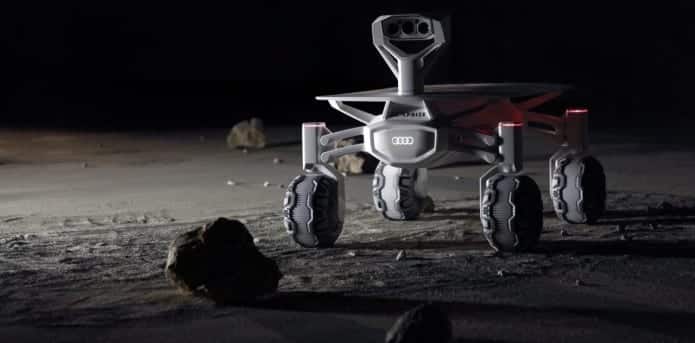Table Of Contents
Google’s $44 million Lunar XPrize moon shoot space race nearing end, additional bonus of $5.8 million for detecting water
There at least a dozen teams who are participating to win Google’s US$30 million (NZ$44 million) prize for reaching to the moon. They are probably going to spend more than seven times that amount, betting the boost to their moon ventures will be worth even more.
The first privately funded team that lands on the moon and then travel 500 metres and transmits high-definition video back to Earth will given the Google’s Lunar XPrize. An additional bonus of US$4 million (NZ$5.8 million) would be given if water is detected.
The teams from India, the US, Japan, Brazil, and Germany view the race as an opportunity to seize the top position in a market that consultant London Economics predicts will be worth US$1.9 billion (NZ$2.7 billion) within 10 years time.
The competitors visualize rare earth elements and mining platinum, setting up habitats using water from lunar polar caps and, in the end, constructing a launchpad for a mission to Mars.
“We are not in it for the prize alone. The race is there to speed innovation that leads to commercialisation of the moon,” said Takeshi Hakamada, whose Tokyo-based Hakuto team is building a lunar rover. “For example, we might explore a lunar cave for possible habitat location. That data would really sell.”
The space travel business is already been commercialised by Elon Musk’s Space Exploration Technologies, or SpaceX, transporting payloads into the Earth’s orbit on its Falcon 9 rocket for US$61 million (NZ$89 million) and presenting private satellite launches for the US government and others.
According to Peter Diamandis, the founder of the award, many times the cash award like the XPrize can attract amount in investment, grant legitimacy to an idea and assist in defining achievable goals. However, winning also needs a feasible business model that can keep the project continuing in existence after the prize money is spent.
HAKUTO MOONRAKER
Named after a folk tale about a moon rabbit, Hakuto has ideas to sell data accumulated by its Moonraker rover to domestic and overseas space agencies. The vehicle is thrown by four wheels decorated with paddles to secure purchase on the moon’s fine-grained dust. A US$500,000 (NZ$732,844) milestone prize from Google has been already won by the design for mobility.
Designed to save the largely consumer-grade electronics inside from the extremes of lunar temperature, the body was made of carbon fibre composite. Hakamada said that a 360-degree camera for collecting detailed images has been placed on the top of the rover.
Nasa’s own images that go back to Apollo missions more than 40 years ago and have a resolution of about half a meter, equivalent to that of Google Maps. Moonraker’s camera provides definition that is nearly a million times greater. The space agency from the US has already said it’s ready to pay private companies US$30 million for fresh data.
FORMING ALLIANCES
It has come into a prize-sharing agreement with an XPrize competitor to get to the moon, as the team has no rockets. Hakuto, which has approximated its total cost at US$10 million, is looking to design a minimum feasible product for lunar exploration and would even think about breaking a success, Hakamada said.
It is taking a ride to the moon with Astrobotic Technology, whose Griffin craft has the ability to finish the trip to lunar surface from Earth’s orbit. Thecompeting rovers will begin the 500-metre dash for Google’s money once they reach there.
Pittsburgh-based Astrobotic makes itself as lunar FedEx and has ideas to make money by transporting commercial and scientific missions to the moon. A can of Pocari Sweat, which is a sports drink made by Japan’s Otsuka Pharmaceutical Company is surrounded by Griffin’s cargo. The container is made as a time capsule. Celestis, a space burial company was another passenger whose customers included counterculture icon Timothy Leary and Star Trek creator Gene Roddenberry.
“The cost to get to space is coming down dramatically,” said John Thornton, chief executive officer of Astrobotic. “That’s why a lunar logistics company can actually make money, something that even 15 years ago would be considered science fiction.”
PRIZE MOTIVATION
In the past too, cash rewards have incited innovation. An 18th century navigation device for ascertaining a ship’s longitude at sea was manufactured in the quest of a prize.
Inspired by the Orteig Prize, the lunar competition gave US$25,000 to Charles Lindbergh for the first non-stop solo flight between New York and Paris in the year 1927.
According to Joe Jackson, whose “Atlantic Fever” records the events said that the race, and the media fever that followed encouraged jump start long-distance aviation commerce. Further, according to NASA, the airline passengers rose 30-fold while the number of planes in the country quadrupled within a year of Lindbergh’s achievement.
“It was a lucky convergence of technology, personalities and finance, and you have some of those elements now,” Jackson said in a phone interview. “People’s attention is grabbed by these kinds of victory-or-death situations, even if the life at stake this time is a robot’s.”

